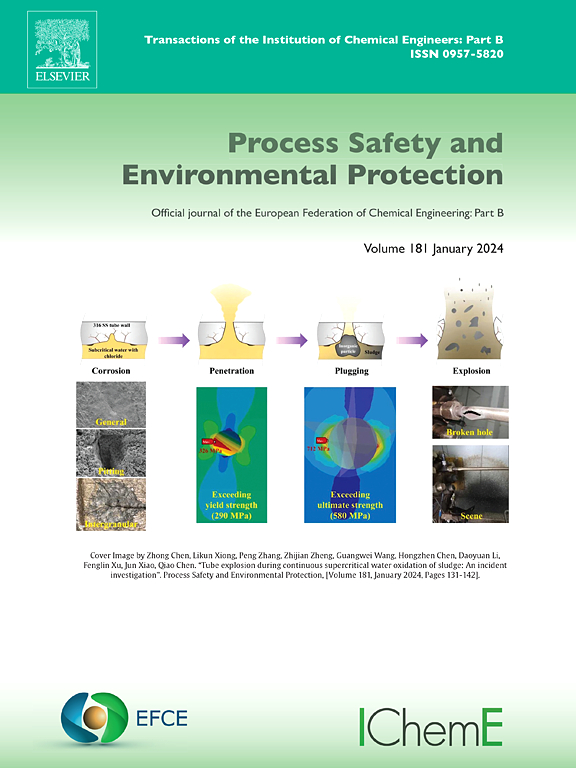Study on utilizing Chinese Baijiu wastewater as an alternative carbon source in full-scale municipal sewage treatment plants
IF 6.9
2区 环境科学与生态学
Q1 ENGINEERING, CHEMICAL
引用次数: 0
Abstract
Yellow water, a byproduct of solid-state fermented Chinese Baijiu production, contains high levels of chemical oxygen demand (COD), posing challenges for wastewater treatment but also offering potential as an external carbon source. This study investigates the viability of using yellow water as a carbon source in full-scale wastewater treatment plants (WWTPs). Compared to a commonly used compound carbon source, yellow water maintained high efficiencies in total nitrogen (TN) (82.94 ± 3.41 % vs. 83.50 ± 2.99 %) and COD removal (96.53 ± 1.00 % vs. 96.65 ± 0.77 %). Additionally, comparable specific denitrification (0.1264 ± 0.0082 g NO3--N g−1 TSS d−1 vs. 0.1157 ± 0.0126 g NO3--N g−1 TSS d−1) and specific nitrification rates (0.1164 ± 0.0121 g NH4+-N g−1 TSS d−1 vs. 0.1092 ± 0.0063 g NH4+-N g−1 TSS d−1) were observed. The addition of yellow water did not significantly affect the relative abundance of the microbial community. Furthermore, using yellow water could reduce costs by $13.27 per ton of Baijiu produced annually and avoid approximately 0.10 tons of CO2 equivalent emissions per ton of Baijiu produced. This approach demonstrates significant potential for reducing the carbon footprint and costs associated with wastewater treatment in the Chinese Baijiu industry while promoting the recovery and reuse of wastewater resources, advancing sustainable wastewater treatment, and fostering a circular bioeconomy.
白酒废水作为城市污水处理厂替代碳源的研究
黄水是固态发酵白酒生产的副产品,含有高浓度的化学需氧量(COD),给废水处理带来挑战,但也有可能成为外部碳源。本研究探讨了在大型污水处理厂(WWTPs)中使用黄水作为碳源的可行性。而常用的复合碳源,黄色的水保持高的效率总氮(TN)(82.94 ± % 3.41 vs 83.50 ±2.99 %)和COD去除率(96.53 ± % 1.00 vs 96.65 ±0.77 %)。此外,比较具体的脱氮(0.1264 ±0.0082 g NO3——N g−1 TSS d−1和0.1157 ±0.0126 g NO3——N g−1 TSS d−1)和特定的硝化率(0.1164 ±0.0121 g NH4 + - N g−1 TSS d−1和0.1092 ±0.0063 g NH4 + - N g−1 TSS d−1)被观察到。添加黄水对微生物群落的相对丰度影响不显著。此外,使用黄水每年每生产一吨白酒可节省13.27美元的成本,每生产一吨白酒可避免约0.10吨二氧化碳当量的排放。这种方法在减少中国白酒行业与废水处理相关的碳足迹和成本方面显示出巨大的潜力,同时促进废水资源的回收和再利用,推进废水的可持续处理,并促进循环生物经济。
本文章由计算机程序翻译,如有差异,请以英文原文为准。
求助全文
约1分钟内获得全文
求助全文
来源期刊

Process Safety and Environmental Protection
环境科学-工程:化工
CiteScore
11.40
自引率
15.40%
发文量
929
审稿时长
8.0 months
期刊介绍:
The Process Safety and Environmental Protection (PSEP) journal is a leading international publication that focuses on the publication of high-quality, original research papers in the field of engineering, specifically those related to the safety of industrial processes and environmental protection. The journal encourages submissions that present new developments in safety and environmental aspects, particularly those that show how research findings can be applied in process engineering design and practice.
PSEP is particularly interested in research that brings fresh perspectives to established engineering principles, identifies unsolved problems, or suggests directions for future research. The journal also values contributions that push the boundaries of traditional engineering and welcomes multidisciplinary papers.
PSEP's articles are abstracted and indexed by a range of databases and services, which helps to ensure that the journal's research is accessible and recognized in the academic and professional communities. These databases include ANTE, Chemical Abstracts, Chemical Hazards in Industry, Current Contents, Elsevier Engineering Information database, Pascal Francis, Web of Science, Scopus, Engineering Information Database EnCompass LIT (Elsevier), and INSPEC. This wide coverage facilitates the dissemination of the journal's content to a global audience interested in process safety and environmental engineering.
 求助内容:
求助内容: 应助结果提醒方式:
应助结果提醒方式:


